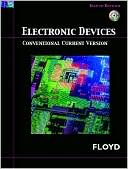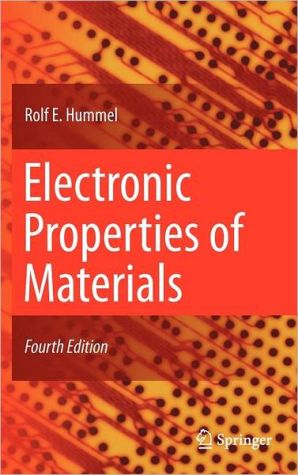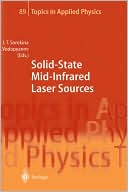Electronic Structure and the Properties of Solids: The Physics of the Chemical Bond
"Should be widely read by practicing physicists, chemists, and materials scientists." — Philosophical Magazine. This innovative text offers basic understanding of the electronic structure of covalent and ionic solids, simple metals, transition metals and their compounds. It also explains how to calculate dielectric, conducting, and bonding properties for each. Includes a useful Solid State Table of the Elements.
Search in google:
This text offers basic understanding of the electronic structure of covalent and ionic solids, simple metals, transition metals and their compounds; also explains how to calculate dielectric, conducting, bonding properties.
Part I. Electron states 1. The quantum-mechanical basis A. Quantum mechanics B. Electronic structure of atoms C. Electronic structure of small molecules D. The simple polar bond E. Diatomic molecules 2. Electronic structure of solids A. Energy bands B. Electron dynamics C. Characteristic solid types D. Solid state matrix elements E. Calculation of spectra Part II. Covalent solids 3. Electronic structure of simple tetrahedral solids A. Crystal structures B. Bond orbitals C. The LCAO bands D. The bond orbital approximation and extended bond orbitals E. Metallicity F. Planar and filamentary structures 4. Optical spectra A. Dielectric susceptibility B. Optical properties and oscillator strengths C. Features of the absorption spectrum D. chi subscript 1 and the dielectric constant 5. Other dielectric properties A. Bond dipoles and higher-order susceptibilities B. Effective atomic charge C. Dielectric screening D. Ternary compounds E. Magnetic susceptibility 6. The energy bands A. Accurate band structures B. LCAO Interpretation of the bands C. The conduction bands D. Effective masses E. Impurity states and excitons 7. The total energy A. The overlap interaction B. Bond length, cohesive energy, and the bulk modulus C. Cohesion in polar covalent solids 8. Elasticity A. Total energy calculations B. Rigid hybrids C. Rehybridization D. The Valence force field E. Internal displacements, and prediction of c subscript 44 9. Lattice Vibrations A. The Vibration spectrum B. Long range forces C. Phonons and the specific heat D. The transverse charge E. Piezoelectricity F. The Electron-phonon interaction 10. Surfaces and defects A. Surface energy and crystal shapes B. Surface reconstruction C. The elimination of surface states, and Fermi level pinning D. Adsorption of atoms and the 7 x 7 reconstruction pattern E. Defects and amorphous semiconductors F. Photothresholds and heterojunctions 11. Mixed tetrahedral solids A. Tetrahedral complexes B. The crystal structure and the simple molecular lattice C. The bonding unit D. Bands and electronic spectra E. Mechanical properties F. Vibrational spectra G. Coupling of vibrations to the infrared Part III Closed-shell systems 12. Inert-gas solids A. Interatomic interactions B. Electronic properties 13. Ionic compounds A. The crystal structure B. Electrostatic energy and the Madelung potential C. Ion-Ion Interactions D. Cohesion and Mechanical Properties E. Structure Determination and Ionic Radii 14. Dielectric properties of ionic crystals A. Electronic structure and spectra B. Dielectric susceptibility C. Effective charges and ion softening D. Surfaces and molten ionic compounds Part IV Open-shell systems 15. Simple metals A. History of the theory B. The Free-electron theory of metals C. Electrostatic energy D. The empty-core pseudopotential E. Free-electron energy F. Density, bulk modulus, and cohesion 16. Electronic structure of metals A. Pseudopotential perturbation theory B. Pseudopotentials in the perfect lattice C. Electron diffraction by pseudopotentials D. Nearly-free-electron bands and Fermi surfaces E. Scattering by defects F. Screening 17. Mechanical properties of metals A. The band-structure energy B. The effective interaction between ions, and higher-order terms C. The phonon spectrum D. The electron-phonon interaction and the electron-phonon coupling constant E. Surfaces and liquids 18. Pseudopotential theory of covalent bonding A. The prediction of interatomic matrix elements B. The Jones zone gap C. Covalent and polar contributions D. Susceptibility E. Bonding properties F. Ionic bonding G. Interfaces and Heterojunctions 19. Transition-metal compounds A. d States in solids B. Monoxides: Miltiplet d States C. Perovskite structures; d Bands D. Other compounds E. The Perovskite ghost F. The chemical grip G. The electrostatic stability of Perovskites H. The electron-phonon interaction 20 Transition metals A. The bands B. The electronic properties and density of states C. Cohesion, bond length, and compressibility D. Muffin-Tin Orbitals and the Atomic Sphere Approximation E. d Resonances and transition-metal pseudopotentials F. Local moments and magnetism Appendix A. The One-electron approximation Appendix B. Nonorthogonality of basis states Appendix C. The overlap interaction Appendix D. Quantum-mechanical formulation of pseudopotentials Appendix E. Orbital corrections Solid state table of the elements Bibliography and author index Subject index








